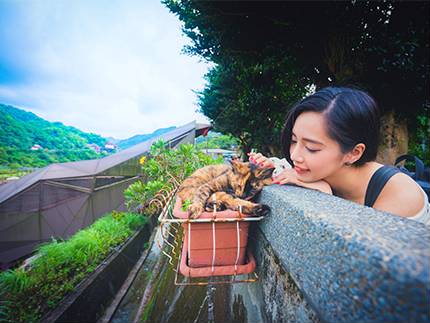
History of Houtong
First, there were monkeys. Then, people found coal. Now, there are cats—and lots of them.
Houtong, which directly means “monkey cave,” is a village in northern Taiwan that was once famous for a local cave full of monkeys. It’s unclear what has since happened to the primates, but in the 1920s when the country was under Japanese colonial rule, coal was found in Houtong. The town quickly became one of the country’s largest coal providers and, soon, 900 households cropped up. Fifty years later, there were about 6,000 people in the village.
But by the 1970s, coal was old news. Younger residents began moving out of the village in search of big city opportunities, and by the 1990s, the mining industry had fizzled out. The population shrunk to less than 100 people and the town’s popularity died down.
But in 2010, Houtong’s fame surged after a cat lover and photographer started blogging about the village’s growing stray cat population. Houtong was transformed into a cat-lover mecca while also providing a source of income for local villagers.
Many of the stray cats, now given affectionate nicknames, are taken care of by local villagers as well as a troop of volunteers.
Turning point of Houtong
An award-winning pedestrian cat bridge was built. Metal plates featuring tiny paw designs were embedded into streets. A cat information and education center opened in 2014, featuring elevated cat walkways on the façade of the building.
A museum park dedicated to the town’s former mining life opened in 2010, later hosting a cat lantern festival in 2012. It all appears to be paying off. The town now draws an estimated one million visitors every year.
Of course, the town itself is crawling with cats. Covering a whole spectrum of shapes and sizes, these friendly felines can be found on and beneath benches, resting on roads, up on tree branches, and roaming where they please. While the cats are adequately fed, they still help the town keep its rat population down.
Obvious signage instructs visitors how to interact with the four-legged locals. The cats should be left alone unless they initiate contact, and they shouldn’t be harassed or chased, the signs instruct. Visitors who choose to feed the cats should clean up afterward, and flash photography is discouraged.
Still, the village isn’t without some problems.
Don’t count your chicken before they hatch.
According to local reports, the town has become a magnet for those looking for a place to abandon their unwanted pets.
During the most recent survey, the New Taipei City Government Animal Protection and Health Inspection Office estimated that the village is now home to about 286 cats — 50 heads more than two years ago.
With the constant patting and feeding from visitors, some also flagged concerns about the health of the furry residents. The department works with local residents and volunteers to vaccinate the cats and provide regular medical treatment.
Signs have been erected around town advising visitors how to behave while also pleading pet owners to be responsible.
在 Instagram 查看這則貼文
在 Instagram 查看這則貼文
*This article is partially reproduced from:
CNN: Houtong: Taiwan village saved by hundreds of adorable stray cats
text by Maggie Hiufu Wong
&
National Geographic: Look Inside Taiwan’s ‘Cat Village’
text by Elaina Zachos
留言